전염단핵구증(엡스타인-바이러스 감염병), Infectious mononucleosis(Epstein-barr virus infection/EBV infection)
(You may visit www.drleepediatrics.com – Volume 7,
Pediatric Adolescent Infectious Diseases or제 7권, 소아 청소년 감염병 질환 웹사이트)
전염성 단핵구증의 원인

그림 4-18. 인두 주위에 있는 림프조직
입을 크게 벌렸을 때 아데노이드는 보이지 않지만 의료기구를 이용해 볼 수 있다. X-선 사진이나 스캔 등으로 아데노이드의 크기를 알아 볼 수 있다.
Copyright ⓒ 2012 John Sangwon Lee, MD. FAAP
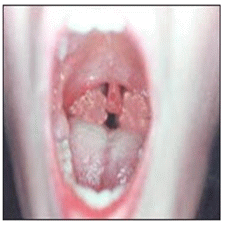
사진과 그림 4-19. 전염성 단핵구증(모노)은 일종의 바이러스 인두 편도염이다. A군 베타 용혈성 연쇄상 구균성 인두 편도염으로 생긴 증상 징후와 전염성 단핵구증으로 생긴 인두 편도염을 증상 징후와 진찰 소견으로만 이 두 병을 감별 진단하기가 어렵다.
Copyright ⓒ 2012 John Sangwon Lee, MD. FAAP
-
엡스타인–바 바이러스(Eptein-Barr virus) 감염으로 생기는 바이러스 감염병을 감염성 단핵구증(엡스타인–바 바이러스 감염병/전염성 모노, 모노 인두 편도염/전염성 단핵구증/키스 병/ 또는 모노)이라 한다.
-
EB 바이러스가 비강, 인두, 편도, 간, 비장, 림프선 등에 동시 감염될 수 있다.
-
그래서 EB 바이러스 비염, 인두염, 편도염, 간염 등이 동시 생길 수 있다.
-
신체 여러 계통에 있는 여러 부위 림프절에도 감염되어 림프절염과 림프증이 생길 수 있다.
-
또 이 병이 있을 때 간장, 비장 등이 부을 수 있다.
-
2~10세 유아들, 학령기 아이들이 EB 바이러스에 감염되면 감기와 비슷한 증상 징후로 앓을 수 있고 아무 증상 징후도 없이 지낼 수 있고 전염성 단핵구증을 앓을 수 있다. 앓은 후 EB 바이러스 항체가 생기는 경우가 많다.
-
일반적으로 5세 이전 대부분 영유아들에게 EB 바이러스 항체가 이미 생겨 있다.
-
EB 바이러스 감염으로 생긴 전염성 단핵구증 인두 편도염의 초기의 증상 징후는 A군 베타 용혈성 연쇄상구균 감염으로 생긴 인두 편도염의 초기 증상 징후와 비슷하다.
-
그 때문에 전염성 단핵구증으로 생긴 인두 편도염인지 A군 베타 용혈성 연쇄상구균 감염으로 생긴 인두 편도염인지 세균 검사나 피 검사를 하지 않고 확실히 감별 진단하기 어려운 때가 많다.
-
키스를 할 때 EB 바이러스에 더 잘 감염되고 이 병에 잘 걸릴 수 있다고 해서 전염성 단핵구증을 “키스 병“이란 별명도 있다.
-
대학 기숙사 생활을 하는 학생들에 이병이 더 잘 발생될 수 있다.
-
키스를 할 때 EB 바이러스가 감염되어 이병에 걸릴 수 있지만 대화나 숨 쉴 때, 또는 기침할 때 나온 비말 속 EB 바이러스에 감염되어 전염성 단핵구증이 생길 수 있다.
-
이 병을 앓는 사람의 피에 접촉되어도 EB 바이러스에 전염될 수 있고 이 병을 앓는 사람과 같이 사는 집안 식구들에게도 EB 바이러스가 감염될 수 있다. 전염성 단핵구증의 증상은 없지만 잠복 감염에 걸린 아이들로부터 EB 바이러스에 감염될 수 있다.
-
잠복기는 10~50일 정도이다.
전염성 단핵구증의 증상 징후
-
전염성 단핵구증의 증상 징후는 다양하다.
-
전염성 단핵구증을 모노라고도 한다.
-
EB 바이러스에 감염되어도 불혈성 감염(잠복 감염)이 생길 수 있고 아무 증상 징후가 없이 EB 바이러스 면역체(항체)만 남기고 자연적으로 나을 때도 있고 감기와 비슷한 증상 징후로 경미하게 앓을 때도 있다.
-
아주 심하게 앓을 수 있다. 특히 영유아들이 전염성 단핵구증을 앓을 때 증상 징후가 없을 때가 많다.
-
EB 바이러스에 감염된 후 10~50일간의 잠복기를 거쳐 4~6일간 전구증이 나타나고
-
4일 내지 2~ 3주 동안 급성 전염성 단핵구증(모노)의 증상 징후가 나타나고
-
2주 내지 1~2개월 간 피로하고 서서히 회복될 때도 있다.
-
심한 전염성 단핵구증을 앓을 때 생길 수 있는 증상을 살펴보면.
-
구개 점막 출혈 반점이 감염성 단핵구증의 초기에 나타날 수 있다. 소스:Dr. Perry Berg
-
미열 내지 고열(76%),
-
인두 통(82%),
-
턱 바로 밑에 있는 목 림프절이나 신체 다른 부위 림프절 비대(84%),
-
구토(5%),
-
구기(12%),
-
두통(31%),
-
전신 권태감과 피로(57%),
-
구미상실(21%),
-
근육통(21%),
-
복통(9%),
-
기침(5%),
-
관절통(2%),
-
인두염과 편도염(84%),
-
림프증(94%),
-
비장 비대(52%),
-
간 비대(12%),
-
황달(5%),
-
홍반(10%) 등이 급성기 모노에 나타날 수 있다.
-
(가로에 있는 %는 각 증상 징후의 발생%이다).
-
겨드랑이와 가랑이 등에 있는 림프절도 부을 수 있고 편도가 크게 붓고 붉고 거기에 하얀 곱이 낄 수 있다.
-
이 때 전염성 단핵구증(모노)을 페니실린이나 아목시실린으로 치료하면 홍반성 피부 발진이 전신에 거의 100% 나타날 수 있다.
-
식욕이 감퇴되고 인두가 아프기 때문에 여러 날 동안 잘 먹지 못해 탈수 될 수 있고 기운이 없어 축 늘어지고 비정상적으로 잠을 많이 자기도 한다.
-
전염성 단핵구증으로 아데노이드염이 생길 수 있고 그로 인해 아데노이드가 상당히 붓고 커져 후비강 기도 부분이 상당히 좁아져서 입을 벌리고 입으로 숨을 쉬기도 한다.
-
EB 바이러스가 뇌 및, 또는 뇌막에 감염되어 무균 뇌막염과 뇌염 등이 생길 수 있다.
-
귈랑–바레 증후군(Guillain-Barre syndrome), 폐렴, 심근염, 백혈구 감소증, 혈소판 감소증, 재생불량성 빈혈, 용혈성 빈혈, 상기도 폐쇄, 비장파열, 간염, 안검부종 등의 합병증도 생길 수 있다.
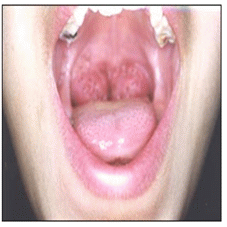
사진 4-20. 전염성 단핵구증으로 편도가 붓고 거기에 염증이 생겼다.
A군 베타 용혈성 연구균 세균검사와 모노검사를 하지 않고서 A군 베타 용혈성 연구균 인두 편도염과 전염성 단핵구증을 확실히 감별 진단할 수 없는 때가 많다.
Copyright ⓒ 2012 John Sangwon Lee, MD. FAAP
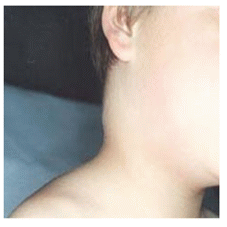
사진 4-21. 전염성 단핵구증성 인두 편도염으로 목에 있는 림프절이 부었다. A군 베타 용혈성 연구균 편도염, 묘소병 또는 결핵 등으로 목의 림프절이 부을 수 있다.
Copyright ⓒ 2012 John Sangwon Lee, MD. FAAP
표 4-5. 전염성 단핵구증의 징후 증상
| 림프절 비대 | 83% |
| 목에 있는 림프절 비대 | 46% |
| 전신에 있는 림프절 비대 | 34% |
| 열 | 86% |
| 인두염 | 57% |
| 하얀 곱이 낀 인두염 | 29% |
| 비장 비대 | 47% |
| 간 비대 | 28% |
| 눈꺼풀 부종 | 10% |
| 피부 발진 | 8% |
| 황달 | 5% |
| 신경에 생기는 비정상 | 1% |
전염성 단핵구증의 진단
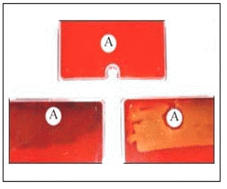
사진 4-22. 용혈성 연쇄상구균이 자란 혈액 우무 배양지
세균배양 검사를 하기 위해 세균배양 인큐베이터 속에 넣기 전 혈액 우무 배양지
인두 점막층이나 편도 점막층에서 면봉으로 채취한 점액을 묻힌 혈액 우무 배양지(상)
A군 베타 용혈성 연쇄상구균이 아닌 잡균이 자란 혈액 우무 배양지(하좌)
비 A군 용혈성 연쇄상구균이 자란 혈액 우무 배양지(하우)
전염성 단핵구증으로 생긴 인두염을 앓을 때 인두 세균 배양검사를 하면 인두의 상존 잡균이 자라고 A군 베타 용혈성 연쇄상구균이 자라지 않는다.
따라서 검사의 결과가 음성으로 나타난다.
Copyright ⓒ 2012 John Sangwon Lee, MD. FAAP
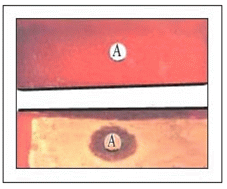
사진 4-23용혈성 연쇄상구균이 자란 혈액 우무 배양지
세균배양 인큐베이터에서 세균 우무 배양지에 자란 인두 상존 잡균(상),
A군 베타 용혈성 연쇄상구균이 자란 세균 우무 배양지(하)
전염성 단핵구증성 인두염을 않을 때 A군 베타 용혈성 연쇄상구균 배양검사의 결과가 음성으로 나타난다.
Copyright ⓒ 2012 John Sangwon Lee, MD. FAAP
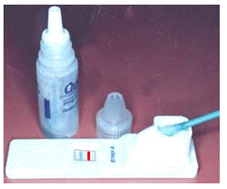
사진 4-24. 전염성 단핵구증을 앓을 때는 모노 항원 항체 응집 반응검사가 양성으로 나타나는 것이 보통이다.
Copyright ⓒ 2012 John Sangwon Lee, MD. FAAP
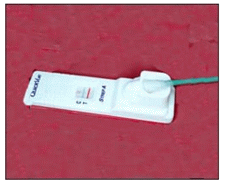
사진 4-25.
A군 베타 용혈성 연쇄상구균편도염을 앓을 때는 A군 베타 용혈성 연쇄상구균 세균 배양검사의 결과가 양성으로 나타난다.
A군 베타 용혈성 연쇄상구균 항원 항체 응집 반응검사도 양성으로 나타나는 것이 보통이다.
요즘 새로 나온 BioStar Strep A Ola Max rapid strep test로 항원 항체 응집 반응검사를 하면 검사결과가 96% 진단특이성이 있다.
그래서 A군 연구균 세균배양 검사를 꼭 할 필요가 없다고 한다.
Copyright ⓒ 2012 John Sangwon Lee, MD. FAAP
-
병력, 증상 징후, 진찰소견 등을 종합해서 이 병을 의심하면 A군 베타 용혈성 연쇄상구균으로 생긴 인두 편도염과 다른 종류의 박테리아 감염성 인두 편도염이나 다른 종류의 바이러스 감염으로 생긴 인두 편도염과 감별 진단해야 한다.
-
인두 편도염을 항생제로 치료를 시작하기 전에 가능한 한 면봉으로 채취한 인두 점액 피검 물로 A군 베타 용혈성 연쇄상구균 세균 배양 검사(“스트렙토검사“”스트렙토테스트/ Strepto test”라고도 부른다)나 A군 베타 용혈성 연쇄상구균 항원 항체 응집 반응검사를 해서 감별 진단하는 것이 보통이다.
-
이런 검사를 하기 바로 며칠 전에 어떤 종류의 항생제로 A군 베타 용혈성 연쇄상구균인두 편도염을 치료받았을 때는 A군 베타 용혈성 연쇄상구균 세균 배양 검사의 결과나 A군 베타 용혈성 연쇄상구균 항원 항체 응집 반응검사의 결과가 허위성 음성으로 나타날 수 있기 때문에 A군 용혈성 연쇄상구균인두 편도염을 확진하기가 어려울 수 있다.
-
A군 베타 용혈성 연쇄상구균인두 편도염은 페니실린이나 그 외 다른 적절한 항생제로 치료 시작한 후 24~48시간 정도 지나면 증상 징후가 아주 좋아지는 것이 보통이나 EB 바이러스 감염으로 생긴 전염성 단핵구증(모노)은 항생제로 치료 받아도 증상 징후가 좋아지지 않는다.
-
CBC 피 검사에 나타난 비정형 림프구, 이종 항체 반응, 모노 테스트, 간 기능검사, IgG 항체, IgM항체, EBNA 검사 등으로 이 병은 비교적 쉽게 진단할 수 있다.
-
EB 바이러스 감염으로 외부 생식기에 궤양이 생길 수도 있다(출처: Pediatrics News October 2008).
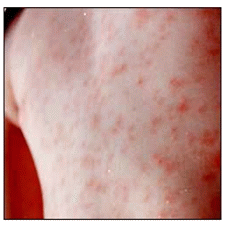
사진 4-26. 전염성 단핵구증으로 생긴 피부 발진
Copyright ⓒ 2012 John Sangwon Lee, MD. FAAP
전염성 단핵구증의 치료
-
EB 바이러스로 생긴 전염성 단핵구증(모노)은 항생제로 치료되지 않기 때문에 대개 대증 치료를 한다.
-
급성으로 증상 징후가 나타날 때는 육체적으로 정신적으로 7~21일 동안 휴식을 취한다.
-
환아가 활동할 수 있을 정도에 따라 육체적 활동을 서서히 한다.
-
음식물은 조금씩 자주 충분히 서서히 섭취하고 수분을 충분히 섭취해서 탈수를 예방한다.
-
병세가 좋아지고 환아가 잘 먹으면 전 유동음식물에서 반 유동음식물로 반 유동음식물에서 보통 먹는 음식으로 점차로 바꾸어 섭취한다.
-
두통, 근육통, 인두통, 열은 타이레놀이나 모트린 등 해열 진통제로 대증 치료를 한다.
-
탈수가 심하면 입원하여 포도당 전해질용액 정맥주사로 재수화 치료한다.
-
아데노이드 비대나 편도 비대 등으로 상기도가 좁아져서 호흡곤란이 있고 그 증상 징후가 심하면 경구용 프레드니손(Prednisone)으로 4-7일 간 치료할 수 있다.
-
Valacyclovir 항 바이러스제로 치료한 결과 치료효과가 좋고 다른 사람들에게 감염시킬 수 있는 감염률도 적어진다고 한다.
-
환자를 격리할 필요는 없다.
-
예방접종 백신은 아직 없다.
전염성 단핵구증 환아들은 언제부터 육체적 운동을 시작할 수 있나
-
진찰, 임상검사, 비장 CT 스캔 검사 등 여러 가지 검사로 언제부터 육체 접촉성 운동을 검사를 할 수 있나 결정하기 어렵다.
-
연구에 의하면, 전염성 단핵구증(모노)의 증상 징후가 생기기 시작한 날 부터 1~14일 사이에 복부 외상을 받으면 비장 파열이 가장 쉽게 생길 수 있다.
-
언제부터 육체 접촉성 운동을 해도 좋은지는 임상적으로 판단해야 가장 좋고
-
비장이 진찰 상 만져지면 육체 접촉성 운동을 삼가는 것이 좋다.
|
다음은 “편도염”에 관한 인터넷 소아청소년 건강상담 질의응답의 예 입니다. |
Q&A. 편도염에 관해서
Q.
안녕하세요… 여기서 궁금한 많은 정보를 읽다가 궁금해서 문의 합니다..
제가 11월 24일부터 아프더니 25일은 열도 나고 기운도 편두통도 심하고 그래서 집에서 하루 쉬면 괜찮아지겠지 생각해서 26일날 쉬었는데도 괜찮아지지 않아서 27일 토요일날 우연히 편도를 보게 되었습니다..
굉장히 많이 부어있고 염증도 있는 거 같아 동네 병원에 갔습니다..
가서 약을 먹고 주사도 맞고 약을 먹어서 괜찮아 지는 듯 싶더니..
새벽에 다시 편두통이 심하게 와서 잠을 이룰 수가 없었습니다..
여전히 목은 부어있고 염증도 있고요..
다음날인 일요일날은 더욱 심해져서 한쪽 편도에만 있던 염증이 다른 한쪽까지 심하게 번져서 침도 삼키기가 힘듭니다..
11월 29일 월요일까지 조제한 약을 먹고 무슨약을 조제해줬는지 병원에 물어보니 6가지였는데 목에 관한 건 오그멘틴이라는 약이었다고 합니다.
그래서 월요일날 다른 병원을 갔습니다..
거기서 약을 하루 조제해 줬는데 오늘다시 와서 검사를 해보고 이약도 듣지 않을 경우 다른 약을 쓸 거라고. 균 검사도 2주 걸리기 때문에 2주 정도 지나면 거의 완치되기 때문에 구지 할 필요 없다고 말씀하시는데..
좀 더 심해지면 입원해서 치료 받으라고 하는데..
계속 여길 다녀야 할지 아님 다른 병원에 가야할지 문의합니다..
그리고 여기서 조제해 준 약은 포비돈 요오드액가글, 세파트리진, 마로나제정, 타스펜이알정, 미렌탈정 이렇게 조제해 주셨습니다..
여기 글을 읽어보면 이 병이 위험할 수도 있는데..
A.
숙희님
안녕하세요. 질문해 주셔 감사합니다.
자녀의 나이, 성별, 과거와 가족의 병력, 진찰소견, 임상검사 결과 등 많은 정보가 있으면 더 좋은 답변을 드릴 수 있습니다.
주신 정보를 참작해 답변을 드립니다.
자세한 정보를 주셔 감사합니다.
그러나 주신 약 이름 “오그멘틴”에 관해서는 무슨 약인지 잘 몰라 답변을 드리는 데 많은 도움을 드릴 수가 없습니다.
그리고 연령이 없어 답변을 드리는 데 많은 지장이 있습니다.
왜냐하면 나이에 따라 생기는 병이 다르기 때문입니다.
질문하신 분의 나이가 15~25세 정도로 추정하고 그런 병으로 저의 소아청소년과에 오신다면 병력을 자세히 듣고 진찰을 해서 편도가 붓고 열이 나고 아프면 바이러스 편도염이 있는지 박테리아 편도염이 있는지 알아보기 위해서 “스트렙토 테스트” 즉 인두점액으로 A군 베타 용혈성 연쇄상구균 배양검사를 저의 소아청소년과에서 한 후 바로 항생제로 치료를 시작하겠습니다.
그렇지 않으면 A군 베타용혈성 연쇄상구균성 항원 항체 응집 반응검사를 해서 양성이면 항생제로 10일간 치료를 시작 하겠습니다.
아시겠지만 바이러스 편도염은 항생제로 치료가 되지 않습니다.
그러나 A군 연쇄상구균성 편도염은 항생제로 잘 치료됩니다.
박테리아 편도염을 항생제로 2~3일 치료하면 증세가 많이 호전되는 것이 보통입니다.
그러나 박테리아 편도 농양이나 편도 주위염은 항생제 치료로만 치료가 잘 되지 않는 경우가 간혹 생깁니다.
또 A군 연구균 편도염은 페니실린으로 잘 치료됐었지만 요즘은 페니실린으로 잘 치료되지 않는 경우도 있습니다.
일반적으로 페니실린으로 치료를 시작한 후 2~3일 내에 치료의 효과가 아주 좋게 나타나는 것이 일반적입니다.
박테리아 편도염의 원인균의 거의가 A군 베타 용혈성 연쇄상구균입니다.
항생제로 치료가 되지 않고 스트렙토 테스트가 음성으로 나타나고 귀하가 가진 증상 징후가 있을 때는 전염성 단핵구증(모노)도 의심해 봐야 합니다.
전염성 단핵구증의 원인은 EB 바이러스 감염이고 그 점염병은 자연히 나을 때까지 기다리든지 대증 치료를 하는 것이 일반적입니다.
요즈음 Valacyclovir항 바이러스제로 치료도 합니다.
이 약으로 치료하면 다른 사람들에게 감염시키는 가능성이 적다고 합니다.
좀 복잡하고 전문적이고 의학적인 말씀을 드리지만 저의 경험으로 미국에서 많은 사람들은 “모노”란 병이 무엇인지 상식으로 잘 알고 있습니다.
아프면 타이레놀로 진통시키고 열이 나면 타이레놀로 해열시키면서 치료하는 것도 또한 중요합니다.
소아청소년과에서 계속 진찰 진단 치료를 받으시고 문제에 관해 상담하시기 바랍니다.
A군 베타 용혈성 연쇄상구균 감염.
[부모도 반의사가 되어야 한다–소아가정간호백과]-제8권 소아청소년 호흡기 질환– 편도염 등을 참조하시기 바랍니다. 질문이 더 있으면 또 방문하세요. 감사합니다. 이상원 드림
Infectious mononucleosis (Epstein-Barr virus infection/EBV infection)
Causes of infectious mononucleosis

Figure 4-18. Lymphatic tissue around the pharynx Adenoids are not visible when the mouth is wide open, but medical devices can be used. You can check the size of adenoids by using an X-ray photo or a scan. Copyright ⓒ 2012 John Sangwon Lee, MD. FAAP

Photo and Figure 4-19. Infectious mononucleosis (mono) is a type of viral pharyngeal tonsillitis. Group A beta hemolytic streptococcal pharyngeal tonsillitis symptoms and pharyngeal tonsillitis caused by infectious mononucleosis are difficult to differentiate between these two diseases only by symptomatic and examination findings. Copyright ⓒ 2012 John Sangwon Lee, MD. FAAP
• A viral infectious disease caused by Eptein-Barr virus infection is called infectious mononucleosis (Epstein-Barr virus infectious disease/infectious mono, mono pharyngeal tonsillitis/infectious mononucleosis/kiss disease/or mono).
• EB virus can simultaneously infect the nasal cavity, pharynx, tonsils, liver, spleen, and lymph glands.
• So, EB virus rhinitis, pharyngitis, tonsillitis, and hepatitis may occur simultaneously. • Lymphadenitis and lymphosis can also develop due to infection of lymph nodes in different parts of the body.
• Also, when you have this disease, the soy sauce and spleen may swell. • Infants 2-10 years old and school-age children can get sick with symptoms similar to a cold, have no symptoms, and develop infectious mononucleosis when infected with the EB virus. EB virus antibodies are often produced after sickness.
• In general, most infants and toddlers before the age of 5 have already developed antibodies to the EB virus.
• The initial symptomatic signs of infectious mononucleosis pharyngeal tonsillitis resulting from EB virus infection are similar to those of pharyngeal tonsillitis resulting from group A beta hemolytic streptococcal infection.
• For that reason, it is often difficult to reliably diagnose whether it is pharyngeal tonsillitis caused by infectious mononucleosis or pharyngeal tonsillitis caused by group A beta hemolytic streptococcal infection without bacteriological or blood tests.
• Infectious mononucleosis is also nicknamed “kiss disease” because it is said that kissing is more susceptible to the EB virus and is more susceptible to the disease.
• Students living in college dorms are more likely to develop morbidity.
• You can get the EB virus from kissing when you kiss, but you can get infectious mononucleosis from the EB virus in the droplets that come from talking, breathing, or coughing.
• Contact with the blood of a person suffering from the disease can lead to transmission of the EB virus, and it can also be contagious to household members living with a person with the disease. Although there are no symptoms of infectious mononucleosis, children with latent infection can be infected with the EB virus.
• The incubation period is about 10 to 50 days. Symptoms signs of infectious mononucleosis
• Symptoms and signs of infectious mononucleosis.
• Infectious mononucleosis is also called mono.
• Even if you are infected with the EB virus, you may develop a hematopoietic infection (latent infection), sometimes heals naturally, leaving only the EB virus immunity (antibody) without any symptoms, and sometimes mildly with symptoms similar to a cold.
• You can get very badly ill. In particular, when infants and toddlers suffer from infectious mononucleosis, there are often no signs of symptoms.
• After being infected with EB virus, the prognosis appears for 4 to 6 days after an incubation period of 10 to 50 days.
• Symptoms of acute infectious mononucleosis (mono) appear for 4 days to 2 to 3 weeks, and
• Fatigue for 2 weeks to 1-2 months and sometimes recovers slowly.
• Looking at the symptoms that can occur when you have severe infectious mononucleosis.
• Palate mucosal hemorrhagic spots may appear early in infectious mononucleosis. Source: Dr. Perry Berg
• mild to high fever (76%),
• Pharyngeal pain (82%),
• An enlarged lymph node in the neck or other part of the body just under the chin (84%),
• vomiting (5%),
• nausea (12%),
• Headache (31%),
• Systemic boredom and fatigue (57%),
• Loss of Europe and America (21%),
• muscle pain (21%),
• Abdominal pain (9%),
• cough (5%),
• joint pain (2%),
• Pharyngitis and tonsillitis (84%),
• an enlarged spleen (52%),
• enlarged liver (12%),
• Jaundice (5%),
• Erythema (10%) may occur in the mono acute phase.
• (The% on the horizontal is the% incidence of each symptom sign).
• Lymph nodes in the armpits and crotch may also be swollen, and the tonsils may be swollen and red, and white mud may stick there.
• At this time, treatment of infectious mononucleosis (mono) with penicillin or amoxicillin can cause erythematous skin rashes to appear in almost 100% of the body.
• Due to decreased appetite and a sore pharynx, you may not be able to eat well for many days, which may lead to dehydration, lack of energy, and sleep abnormally.
• Infectious mononucleosis can lead to adenoiditis, which causes the adenoid to become quite swollen and enlarged, causing the posterior nasal airway to become considerably narrower, causing the mouth to open and breathe through the mouth.
• EB virus can infect the brain and/or meninges, resulting in aseptic meningitis and encephalitis.
• Guillain-Barre syndrome,
- pneumonia,
- myocarditis,
- leukopenia,
- thrombocytopenia,
- aplastic anemia,
- hemolytic anemia,
- upper respiratory tract obstruction,
- spleen rupture,
- hepatitis, and eyelid edema.

Photo 4-20. With infectious mononucleosis, the tonsils are swollen and inflamed. In many cases, it is not possible to reliably differentiate between pharyngeal tonsillitis and infectious mononucleosis of group A beta-hemolytic bacteria without bacteriological and mono-tests. Copyright ⓒ 2012 John Sangwon Lee, MD. FAAP

Photo 4-21. Infectious mononucleosis pharyngeal tonsillitis swollen lymph nodes in the neck. Group A beta-hemolytic research bacteria can cause swollen lymph nodes in the neck due to tonsillitis, catarrhal disease, or tuberculosis. Copyright ⓒ 2012 John Sangwon Lee, MD. FAAP
Table 4-5. Signs and symptoms of infectious mononucleosis
표 4-5. 전염성 단핵구증의 징후 증상
| Enlarged lymph nodes | 83% |
| Enlarged lymph nodes in the neck | 46% |
| Enlarged lymph nodes throughout the body | 34% |
| fever | 86% |
| pharyngitis | 57% |
| Pharyngitis with white mucous | 29% |
| splenomegaly | 47% |
| hepatomegaly | 28% |
| eyelid edema | 10% |
| skin rash | 8% |
| jaundice | 5% |
| Abnormalities in the nerves | 1% |
Diagnosis of infectious mononucleosis

Photo 4-22. Hemolytic streptococcus-grown blood mud culture medium Blood mud culture paper before placing in a bacterial culture incubator for a bacterial culture test Blood mucous culture paper (top) with mucus collected with a cotton swab from the pharyngeal mucosa or tonsil mucosa Group A beta-hemolytic streptococcus non-hemolytic cell culture medium (bottom left) grown with various bacteria Non-A group hemolytic streptococcus-grown blood broth culture (how) When you have a pharyngitis caused by infectious mononucleosis, if you perform a pharyngeal bacterial culture test, the pharyngeal bacteria grow and group A beta-hemolytic streptococcus does not grow. Therefore, the result of the test appears negative. Copyright ⓒ 2012 John Sangwon Lee, MD. FAAP

Picture 4-23Brain culture medium with blood overgrown with hemolytic streptococcus Pharyngeal supernatant bacteria (top) grown in a bacterial culture incubator Bacteria grown with group A beta-hemolytic streptococcus (bottom) In the absence of infectious mononucleosis pharyngitis, the results of the group A beta-hemolytic streptococcus culture test were negative. Copyright ⓒ 2012 John Sangwon Lee, MD. FAAP

Photo 4-24. When suffering from infectious mononucleosis, it is common for a mono-antigen antibody agglutination test to be positive. Copyright ⓒ 2012 John Sangwon Lee, MD. FAAP

Photo 4-25. When suffering from group A beta-hemolytic streptococcal tonsillitis, the result of group A beta-hemolytic streptococcal bacterial culture test is positive.
A group A beta-hemolytic streptococcal antigen-antibody aggregation test is also usually positive. When the antigen-antibody agglutination test is performed with the new BioStar Strep A Ola Max rapid strep test, the test result has a diagnostic specificity of 96%. Therefore, it is not necessary to test for the bacterial culture of group A research bacteria. Copyright ⓒ 2012 John Sangwon Lee, MD. FAAP
• If you suspect this disease based on your medical history, symptoms, and medical examination findings, you should differentiate between pharyngeal tonsillitis caused by group A beta-hemolytic streptococcus and pharyngeal tonsillitis caused by other types of bacterial infectious pharyngeal tonsillitis or other types of viral infections.
• Group A beta-hemolytic streptococcal bacterial culture test (also referred to as “Strepto test” or “Strepto test”) or group A beta-hemolytic with a pharyngeal mucus specimen collected with a cotton swab before starting treatment with antibiotics for pharyngeal tonsillitis. It is common to perform differential diagnosis by performing a streptococcal antigen-antibody agglutination test.
• When a group A beta-hemolytic streptococcal tonsillitis was treated with some kind of antibiotic just a few days before such a test, the results of the group A beta-hemolytic streptococcus bacterial culture test or the result of the group A beta-hemolytic streptococcal antigen-antibody aggregation reaction test It may be difficult to confirm group A hemolytic streptococcal pharyngeal tonsillitis because is a false negative.
• Group A beta-hemolytic streptococcal tonsillitis usually improves symptoms 24 to 48 hours after starting treatment with penicillin or other appropriate antibiotics, but infectious mononucleosis (mono) caused by EB virus infection is usually treated with antibiotics. Symptom signs do not improve.
• CBC blood test shows atypical lymphocytes, heterologous antibody reaction, mono test, liver function test, IgG antibody, IgM antibody, EBNA test, etc. This disease can be diagnosed relatively easily.
• EB virus infection may cause external genital ulcers (Source: Pediatrics News October 2008).

Photo 4-26. Skin rash caused by infectious mononucleosis Copyright ⓒ 2012 John Sangwon Lee, MD. FAAP Treatment of infectious mononucleosis
• Infectious mononucleosis (mono) caused by the EB virus is usually treated as symptomatic because it is not treated with antibiotics.
• When symptoms appear acutely, take a break for 7 to 21 days, physically and mentally.
• Do physical activities slowly depending on the extent to which the child can be active.
• Eat food little by little, often enough, slowly, and drink plenty of fluids to prevent dehydration.
• If the sickness improves and the child eats well, gradually change from whole food to semi-fluid food and semi-fluid to normal food.
• Headache, muscle pain, sore throat, and fever are symptomatic treatments with antipyretic analgesics such as Tylenol or Motrin.
• If dehydration is severe, hospitalize and receive rehydration treatment with an intravenous glucose electrolyte solution.
• If you have difficulty breathing due to narrowing of the upper airway due to enlarged adenoids or enlarged tonsils, and the symptoms are severe, oral prednisone can be treated for 4-7 days.
• As a result of treatment with an antiviral agent of Valacyclovir, the treatment effect is good and the rate of infection that can infect other people is low.
• There is no need to isolate the patient.
• There is still no vaccination vaccine. When can children with infectious mononucleosis start physical exercise?
• It is difficult to determine when physical contact movement can be tested with various tests such as medical examination, clinical examination, and spleen CT scan.
• Studies have shown that rupture of the spleen is most likely to occur if an abdominal trauma occurs between 1 and 14 days from the start of the onset of symptoms of infectious mononucleosis (mono).
• It is best to clinically judge when it is okay to do physical contact exercise.
• If the spleen is touched during the examination, it is better to refrain from physical contact exercises.
The following is an example of the Internet pediatric and adolescent health counseling question and answer on “tonsillitis”.
Q&A. About tonsillitis
Q.
Hello… I’ve been reading a lot of information I’ve been curious about here, and I’m curious about it. I got sick from November 24th, and on the 25th I had a fever, my energy, and a migraine, so I thought that it would be okay if I took a day off at home.
I went to the local hospital because it was very swollen and inflamed. Going to take medicine, getting an injection, and taking medicine, I felt like I was getting better…
At dawn, I had a migraine again and I couldn’t sleep.. My throat is still swollen and inflamed.. The next day, Sunday, it gets worse, so the inflammation that was only on one side of the tonsils spreads to the other, making it difficult to swallow saliva.
When I asked the hospital what drugs they had prepared after taking the drugs prepared by Monday, November 29th, there were 6 things, and they said that the throat was a drug called augmentin. So I went to another hospital on Monday…
I prepared the medicine there for a day, but if I come back to do the test today, and I don’t take this medicine, I will use another medicine. They say that you don’t need to go back because it takes two weeks to test for bacteria, so it will be almost completely cured after two weeks. If it gets worse, they tell you to be hospitalized and treated..
I ask if I should continue to visit or if I should go to another hospital. And the medicines I prepared here are povidone iodine liquid gargle, cefatrigin, marona formulation, taspene ial tablet, and Mirental tablet. If you read the text here, this disease can be dangerous…
A.
Sook-hee Good morning.
Thank you for asking. If you have a lot of information, such as your child’s age, gender, past and family history, medical examination findings, and clinical test results, we can give you a better answer.
We will respond by taking the information you provided into consideration. Thank you for the detailed information. However, regarding the name “Augmentin,” the drug you gave me, I am not sure what kind of medicine it is, so I cannot help you much to answer.
And since I’m not old, I have a lot of trouble in responding. This is because the diseases that occur with age are different.
If the person who asked the question is estimated to be 15 to 25 years old, and if you come to my pediatrics department with such a disease, listen closely to your medical history and have a medical examination to see if you have viral tonsillitis or bacterial tonsillitis if you have swollen tonsils, fever, and soreness.
Test” In other words, I will start treatment with antibiotics immediately after performing a group A beta-hemolytic streptococcus culture test with pharyngeal mucus at my pediatrics department.
Otherwise, a group A beta-hemolytic streptococcal antigen-antibody agglutination test is performed, and if positive, treatment with antibiotics will be started for 10 days. As you may know, viral tonsillitis cannot be treated with antibiotics.
However, group A streptococcal tonsillitis is treated well with antibiotics. Bacterial tonsillitis is usually treated for 2-3 days with antibiotics to improve symptoms.
However, bacterial tonsil abscesses or peritonitis sometimes do not work well only with antibiotic treatment.
In addition, group A beta-hemolytic streptococcus tonsillitis was well treated with penicillin, but these days, there are cases that are not well treated with penicillin.
In general, it is common for the treatment to be very effective within 2 to 3 days after starting treatment with penicillin.
Most of the causative agents of bacterial tonsillitis are group A beta-hemolytic streptococcus. Infectious mononucleosis (mono) should also be suspected if antibiotics do not treat it, and the strep test is negative and you have any signs of symptoms.
The cause of infectious mononucleosis is infection with the EB virus, and it is common to wait for the infectious disease to heal spontaneously or to treat it as symptomatic.
These days, it is also treated with Valacyclovir antiviral drugs. Treatment with this drug is said to be less likely to infect other people.
I’m going to tell you a bit more complicated, professional, and medical, but from my experience, many people in the United States know with common sense what the term “mono” is. It is also important to treat pain with Tylenol if you are sick, and treat it with Tylenol if you have a fever. Please continue to receive medical examination and treatment at the Department of Pediatrics and Adolescents and discuss your problem.
Group A beta-hemolytic streptococcal infection. www.drleepediatrics.com]-Volume 8 Children and Adolescents Respiratory Diseases-Tonsillitis, etc. Please refer to. If you have more questions, please visit again. Thank you. Lee Sang-won
출처 및 참조 문헌 Sources and references
- NelsonTextbook of Pediatrics 22ND Ed
- The Harriet Lane Handbook 22ND Ed
- Growth and development of the children
- Red Book 32nd Ed 2021-2024
- Neonatal Resuscitation, American Academy Pediatrics
- www.drleepediatrics.com제7권. 소아청소년 감염병
- Red book 29th-31st edition 2021
- Nelson Text Book of Pediatrics 19th – 21st Edition
- The Johns Hopkins Hospital, The Harriet Lane Handbook, 22nd edition
Copyright ⓒ 2015 John Sangwon Lee, MD, FAAP
“부모도 반의사가 되어야 한다”-내용은 여러분들의 의사로부터 얻은 정보와 진료를 대신할 수 없습니다.
“The information contained in this publication should not be used as a substitute for the medical care and advice of your doctor. There may be variations in treatment that your doctor may recommend based on individual facts and circumstances. “Parental education is the best medicine.”